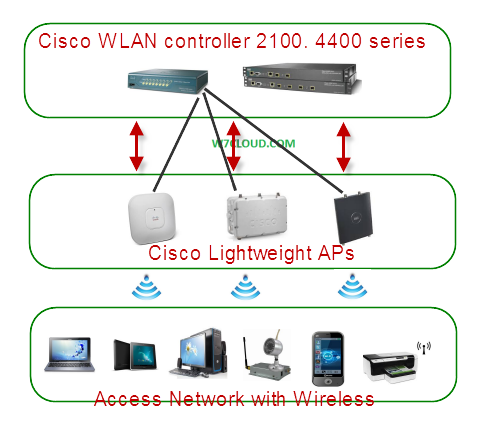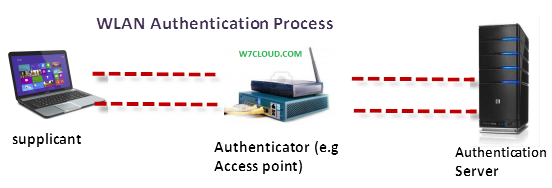Designing a network?
For designing a network against any requirements you can use the following eight steps design methodology. Which have a complete detail and procedure for designing any network.
- Recognize Customer needs
- Describe the existing Network
- Design networking & topology Solution
- Plan the network implementation
- Construct a prototype network
- Fully Document the Design
- Implement the Dsign
- Verify , monitor and modify as needed
1. Network Design Requirements |Identifying Customer Design Requirements:
Network designing process starts from information gathering from customer, to obtain customer requirements, you need to communicate with network engineers, business unit personnel and company managers. You can identify the customer requirements by directory talking to customer. As a network designer you need following steps to identify customer requirements:
- Identify network applications and services that the organization wants to run in it network.
- Define the organizational goals.
- Define the possible organizational constraints and limitations, these limitations may be related to cost.
- Define the technical goals
- Define the possible technical constraints.
After you complete above these steps, you then analyze the data and develop a network design.You need to identify current and planned applications and determine the importance ofeach application. For example is email as important as customer support? VOIP services are required or not?
Identify network applications and services:
Figure out all the applications required for an organization and list them. You need to find out which network applications need high-availability and high-bandwidth you need to create and prepare a plan for these applications and services.
Planned application types
: you need to define an application for different required services suchas for email, exchange server and outlook at client end, for collaboration and voice services Cisco call manager or Microsoft Lynccan be used and also same for other service like web browsing, filesharing and database. Also have to find out the Business importance of different application and labeled them as critical, important, or unimportant. For example for some organization email may a critical application as compare to instant messaging.
Also list the additional network services like security,quality of service (QoS), network management, high availability, unified communications,mobility, and virtualization.
Define the organizational goals
Organizational goals are related to company’s development, you should identify whether the company’s goal is to improvecustomer support, add new customer services, increase competitiveness, or reducecosts. It might be a combination of these goals, with some of them being more importantthan others. Some organizational goals are as follows:
- Quality of Service
- Increase competitiveness
- Reduce costs
- Improve customer support
- Add new customer services
Define the possible organizational constraints and limitations
Organizational constraints and limitations include cost, personnel, policy, and time limitations. The organizationmight have some limitations related to cost and you may be given a certain budget or timeframe to complete the project. The organization might require the projectto be completed in an unreasonable timeframe. It might have limited personnel to supportthe assessment and design efforts, or it might have policy limitations to apply certainstandard and protocols. For example for some organization,you may need to implement different policies and certain level of security because of HIPPA certification and requirements.
Define the technical goals
Technical goals support the organization’s objectives and the supported applications.
Some Technical goals include the following:
- Improve network security
- Implement QoS
- Improve the network’s response-time,throughput
- Decrease network failures and downtime (high availability)
- Simplify network management
- Improve reliability of mission-critical applications
- Updateout-of-date technologies with latest technologies
- Improve the network’s scalability
Define the possible technical constraints
Network design might be affected with different technical constraints. Legacy applicationsmight still exist that must be supported going forward, and these applicationsmight require a legacy protocol that may limit a design. Technical constraints include existing cablingthat does not support new technology, low bandwidth might not support new applications. So you need to find all the technical constrains and solution against each constrain.
2.Describe the Existing Network
Characterizing the existing network is second step of the network design methodology. In this step, you need to identify a network’s existing infrastructure and services that are currently running. You can use the different tools to analyze existing network traffic, and toolsfor auditing and monitoring network traffic.
For describing the existing network you need to visit the site and all the existingdocumentation related to current network are great source of obtaining the information related to existing network. Sometimes no documented information exists. You should be prepared touse different tools to obtain information and get access to log into the network devices to obtaininformation. Following are the steps for gathering information:
Identify all existing organization information and documentation:
Exiting network documentation can provide you different information such as
- Site names
- Sitelocation
- Site contacts
- Cabling layout and track within the building
- Server room location
- Operational hours of office
- Networkinfrastructure information like:
- locations and types of servers and network devices
- WAN technologies and circuitspeeds
- Power used
- Logical network information includes IP addressing, routing protocols,network management, and security ACLs.
Perform a network audit that adds detail to the description of the network.
For information gathering of existing network you can perform network audit, you can perform this audit the help of existing documentation, existing network management software toolsand with some otheraudit tools.After gathering the existing documentation, you must obtain access to the existing managementsoftware. The client may already have CiscoWorks tools from which you can obtainhardware models and components and software versions. You can also obtain theexisting router and switchconfigurations.
The network audit should provide you the network device list, hardware models, versions of software, configuration of network devices, interface speeds, link, CPU, bandwidth and memory utilization.
In small network, you might be able to acquire the necessary information via a physicaljudgment, but for larger network, a manual assessment is a time-consuming. Manual assessment includes the using of commands to find the configuration of different devices, normally “show commands” provide you the information relation to devices information like model, configuration etc. Some of examples of show commands (Cisco) are:
- show running-config
- show tech-support
- show version
- show interface
- Show Ipint brief
- show processes cpu
- show log
For large network you can use differentNetwork auditing and Analysis tools including:
Network auditing tools
CiscoWorks: Maps the network and collects network topology, hardware andsoftware versions, and configurations.
Network-Based Application Recognition (NBAR): Cisco developed Network-Based Application Recognition as part of its Content Networking platform for implementing intelligent network services like available resources are utilized as efficiently as possible.
NetFlow: Provides a view of network traffic flows on a specific network interface.
Cisco Operations Manager is also a handy tool.
Some third-party tools are AirMagnet Survey PRO, Stats Manager,Yellowjacket, Redcell engineering pro, NetcordiaNEtMRI, Netformix, NetQoS, and Pari Networks.
Network Analysis Tools
For application-level information you may need the details of IP packetsfor this you can use different analysis tools and software. Network analysistools include the following:
- NetformxDesignXpert Enterprise
- CNS NetFlow Collector Engine
- Cisco Embedded Resource Manager (ERM)
Third-party tools: Such as Sniffer, AirMagnetWifi Analyzer, BVS Yellowjacket802.11, NetIQ Vivinet Assessor, NetcordiaNetMRI, and SolarWinds Orion.
3. Designing the Network Topology and Solutions
In this step or section of eight step design methodology you have to select the network topology and need to prepare the network solution for organization. The best approach to design the network topology is the structure approach which allows you to develop the optimal solution with lower cost with fulfilling all requirements of customer like capacity, flexibility, functionality, performance, scalability and availability.
Network solution includes the things like WAN technologies, LAN services and all devices through which you can implement this network solution.
You can start the network designing process with information that you extract through:
- Existing information and documentation
- Network audit
- Traffic analysis
Cisco recommends you to use the top-down approach for designing the network topology and solution. Aspart of the Design phase you can use PPDIOO methodology, or a top-down approach is usedthat begins with the organization’s requirements before looking at technologies. Networkdesigns are tested using a pilot or prototype network before moving into theImplement phase.
Top-down design just means starting your design from the top layer of the OSI model andworking your way down. Top-down design adapts the network and physical infrastructureto the network application’s needs. With a top-down approach, network devices and technologiesare not selected until the applications’ requirements are analyzed.
4. Plan the network implementation
The 4th step is plan the network implementation which involves the good degree of documentation, diagram and other related material. In documentation you should have the step-by-step procedure of each aspect of modular network and have the complete detail for implementation of each step. Documentation must have rollback plan for each step, if something goes wrong you can back to previous step and after modification you can re-implement that step again.
Another important aspect of network implementation plan is to define the time frame for each steps or each modules, you can include your project managers for these purposes. Also make sure that you include the test at every step in the process. And for simplicity you can break down complex procedures into small chunks which provide the better understanding and easy implementation.
5. Construct a prototype network or a Pilot site for testing of network Design
During the network designing and implementation when you finish a new module of network or deploy the design to small site, before the full implementation, it is a best practiceto test the new solution. This testing can be done in one of two ways: prototype orpilot.
A prototype network is a subset of the full design, tested in an isolated environment. Theprototype does not connect to the existing network. The benefit of using a prototype isthat it allows testing of the network design before it is deployed before affecting a productionnetwork. When implementing a new technology such as IPsec, you might want toimplement a prototype test before deploying it to the operational network.
A pilot site is an actual “live” location that serves as a test site before the solution is deployedto all locations in an enterprise. A pilot allows real-world problems to be discoveredbefore deploying a network design solution to the rest of the internetwork.
With both a prototype and a pilot, successful testing leads to proving the design and movingforward with implementation. A failure leads to correcting the design and repeatingthe tests to correct any deficiencies.
6. Fully Document the Design | Network Design Document
Documenting the project is the best practice and has a number of advantages and future benefits.
The design document describes the business requirements, also including the old network architecture, networkrequirements, design, plan, and configuration information for the new network.The network architects and analysts use it to document the new network changes, and itserves as documentation for the enterprise. For network design-document you can follow the standard process for creating the document. This procedure includes the introduction of project, designing requirement, detail about the existing network, design, proof of concepts, implementation of plan and appendixes. Short description of each document module is as under:
Introduction describes introductory information related to the project’s purpose and the reasons for the network design.
Design Requirements lists the organization’s requirements, constraints, and goals.
Existing Network Infrastructure includes logical (Layer 3) topology diagrams; physicaltopology diagrams; audit results; network health analysis; routing protocols; asummary of applications; a list of network routers, switches, and other devices; configurations;and a description of issues.
Network Design contains the specific design information, such as logical and physical topology, network diagrams, IP addressing, routing protocols, and security configurations.
Proof of Concept results from live pilot or prototype testing.
Implementation Plan includes the detailed steps for the network staff to implementthe new installation and changes.
Appendixes contains list of exiting network devices, configurations, and additionalinformation used in the design of the network.
7. Implement the Design
In implementation phase network engineer implement the network’s designer design. In this phase network engineer implement the documented steps, network diagram into real network.
The first six step of eight step design model is related to CCDA and where you have to design and document the projectwhereas the remaining two steps are related to implementation and verification which is the part of CCNP.
8. Verify , monitor and modify as needed
Once your network is fully implemented then your job to run and operate the network properly, you have to monitor the network devices, traffic and other security aspects. You can make the modification if you find something wrong with network operation during monitoring of network. Also if you need to add some more services and feature you can add these services too.













